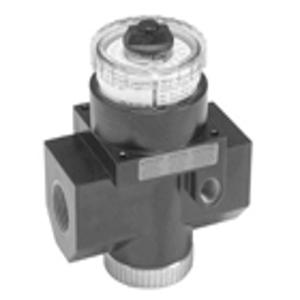Wilkerson R31-08-000 dial-air regulator is ideal for controlling and regulating the pressure of compressed air in pneumatic systems. It is an essential component in the manufacturing, automation and construction industries.
Features:
- This dial-air regulator features a zinc body for corrosion resistance and a nitrile seal for leakproof connections.
- It has a balanced valve design, ensuring precise regulation of air pressure by maintaining stability and accuracy during operation.
- This Wilkerson R31-08-000 regulator offers a non-rising pressure adjusting dial for convenient adjustment of air pressure without the need for upward movement.
- It includes a piston-operated mechanism, ensuring smooth and reliable regulation of air pressure with minimal friction.
Frequently Asked Questions:
Q. What is the difference between a relieving and a non-relieving air regulator?
A. A relieving air regulator is designed to release excess pressure from the system when the set pressure is exceeded, ensuring that the pressure remains within the specified range and preventing damage to equipment. In contrast, a non-relieving air regulator does not release excess pressure and maintains the pressure within the system even if it exceeds the set point.
Q. What safety precautions should I take when using this Wilkerson R31-08-000 dial-air regulator?
A.
- Read the manual thoroughly to understand installation, adjustment and maintenance procedures.
- Wear appropriate personal protective equipment (PPE) like safety glasses and gloves.
- Inspect the regulator for damage such as cracks or leaks before use.
- Adjust air pressure cautiously within recommended limits to prevent overpressure.
- Regularly monitor pressure levels using gauge ports to avoid system damage.
- Do not exceed the maximum pressure rating to prevent equipment failure.
- Keep the area around the regulator clear to avoid interference with operation.
- Shut off the air supply and depressurise the system before maintenance or adjustments.
Q. How do I maintain and troubleshoot an air regulator?
A. Regular maintenance involves checking for air leaks, cleaning & inspecting the regulator components and ensuring proper lubrication if required. Troubleshooting includes addressing pressure inconsistencies, excessive vibration or irregular operation.



